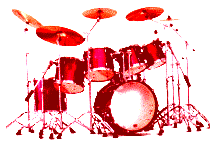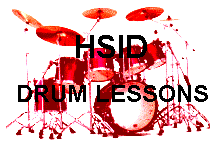|
Downloads *
Drummers Trivia *
Drummers Chat Rooms *
Rudiments *
Digital Music *
Knowledge Assessments *
TD Archives *
Drum Set Buyers Guide *
Bass-Player Jokes *
Assembling a Drum Set *
Parts of a Drum Set *
About HSID *
Video Troubleshooter
Bill Powelson's School of Drums
School of Drums
Back to the Tempo Dispatch Archives
ISSUE #78 \__\__\___TEMPO DISPATCH ___/__/__/ June 5, 2003
MONTHLY NEWSLETTER / DRUM SET LESSONS
Copyright Bill Powelson 2003 all rights reserved.
________________'IT'S ALL ABOUT DRUMS'______________
* Tips * Tricks * Hints * F*r*e*e Drumset-Lessons *
__________Now more than 13,500+ SUBSCRIBERS__________
IN THIS ISSUE . . . (TABLE OF CONTENTS . . .)
(Feature-Article/lesson)
1. DRUMS & CHARTING - When & Where to Count Difficult Rhythms.
2. The Groove Guides are temporarily out of stock. Sorry!
3. Humor: Why God Created Eve.
4. Play the new DRUMMERS TRIVIA GAME.
_______________________________________
|__DRUM CHARTING & COUNTING TIP(S)_____|
Most of the time, as we play by feel and by
ear, it isn't really necessary to do a lot
of counting or charting.
If you've been following all my lessons, you should
be playing 95% of all songs with reasonable proficiency
by now, without consciously-counting or charting. This
usually begins to occur (for most students) within the
first 10 or 12 lessons of the 125-lesson course.
However, there are times, (with some
difficult rhythms) . . . we sometimes just can't seem
to 'feel' the timing.
* Some songs may contain so many changes and intricate
rhythm patterns that a chart, or some conscious counting
may be needed.
It's best if we can write our own charts, rather than
waste 29 hours, searching for enigmatic, pre-written charts,
on the web.
No! I don't devote 29 hours searching the web for
a pre-written chart that someone else has written. I
simply LISTEN TO THE SONG and WRITE MY OWN CHARTS, usually
in under 3-minutes.
Hopefully, YOU are about to learn how to do that too!
....................................................
PAID STUDENTS:
For additional help reading and writing drum notation,
see the following two lessons in the TD Archives:
TD #13
TD #14
.....................................................
COUNTING:
When, Where, Why and How to Count . . .
I've developed a system over the years. Maybe it
will help some of you . . .
* Normally, we only count if we're having a particularly
hard time 'feeling' a particular rhythm pattern..
Most songs follow the same GENERAL patterns. After
awhile, we tend to know instinctively what is coming
next in nearly any song . . . even though we may never have
heard or played the song before. We usually feel the count
and the beat, . . . (once we know our BASIC BEAT PATTERNS:)
In MOST cases, we may not need to do much conscious counting,
and we probably won't need a chart at all.
Yet, there are those occasional songs which may contain
a technique or two that we just can't seem to play,
automatically.
That is when, where and why we may need to
consciously count an arrangement of a song.
HOW TO COUNT:
If anything needs to be counted . . . I find a reference
point within the music (usually a particular word in the
lyrics), and begin counting a bar or two before the 'hard
to play' technique.
...........................................................
REMEMBER: The count of ONE is arbitrary when we begin
counting/writing in mid-song. The DOWNBEAT is the only
reference-point we actually need. It doesn't matter
whether it is a ONE-COUNT of the bar, or a THREE COUNT
of the bar, in relation to the (non-existent) written
sheet music.
We are writing for ourselves at this point . . . and the
starting downbeat (our count of one) may be of our choosing.
POINT:
ANY 'downbeat' in mid-song 'could' be the count of one,
as our beginning reference point, to help us FEEL the part.
...........................................................
Simply choose a downbeat just before the hard-to-play portion
of the song, begin counting with ANY DOWNBEAT as your ONE count.
Count your way through the difficult part. Notice exactly when
the difficult pattern emerges within your count . . . and also
notice where it ends.
Turn the music off and try to consciously count and
play the pattern as you've just heard it played, on the recording.
Continue to do this, until you have the difficult pattern
under control. Write the pattern in 'real notation', on paper, if
necessary, then study it!
Finally, proceed to MEMORIZE the rhythm-pattern exactly as it
occurs within your count, your written notation, and on
the recording.
'WHY' WE MAY NEED TO CONSCIOUSLY COUNT:
Of course we are sub-consciously counting almost
all the time as any song plays, though we aren't actually
thinking in terms of numbers. We simply tend to 'feel' the
count naturally most of the time. But, if we can't 'feel'
the count naturally, we may need to count in a more
conscious way, and/or write ourselves a simple chart.
HERE'S MY UNIQUE 'SHORTHAND-CHARTING' METHOD . . .
Sometimes, for special shows we may play, it might
become necessary to learn 8 or 10 songs at one time, and
be ready to play them flawlessly onstage within an hour
or two.
Sometimes it can be too much to remember!
THAT'S WHEN we made need to write our own short-hand charts.
Haha . . . don't laugh too hard at this . . .
it's a pretty UNIQUE way of doing things. The following
way works for me, though it may not be ready for
prime-time . . . or for ALL students.
* First, I play the recorded (tape) on FAST SPEED . . .
as I write a quick, shorthand drum-chart or tab.
YES!
With a little practice it's becomes pretty easy to
'shorthand-code' a song, FASTER than it plays on
REGULAR speed . . . (That's why I do it on fast-speed.)
Speeding up the tape . . . saves time, that's all.
* You may prefer to do all this on 'regular speed' as
you are learning. After a little practice at this though,
you'll hopefully find that you too will knock out a quick-charts
with one quick-listen . . . as a song plays on fast-speed.
It isn't all that hard to do, with a little serious effort.
Our charts are just for us. We normally only use them at
home as we learn (memorize) new song(s), in exactly
the way our band (or we) will want them played onstage.
SHORTHAND-CHARTING:
As a song plays on FAST speed . . . I quickly jot
down the beat-type(s), and/or beat changes, in notation
(if necessary . . .) and where the changes occur within
the song.
At the same time, I locate all the fills and quickly notate
them, according to WHERE they are in the song, such as . . .
* EV = End-of-verse, 1, 2, 3, or 4.
* /C = Going into the chorus . . .
* /R = Into the ride . . .
I chart the song according to whatever I hear the drummer
playing in the recording of the song.
(See the sample-chart, below.)
Then . . . Once I've noted and memorized WHERE all the
important parts are occurring . . . I put the tape on REGULAR speed,
take my place at the kit, and play along with the song two or
three times, until I'm sure I can make it smoke, onstage.
My own shorthand (tabs?) might look something like
the sample-chart below . . .
There aren't any RULES here! Do it in your own
way! You'll become the master of your OWN shorthand-codes.
..........SAMPLE CHART...........
SONG TITLE: 'So and So Song'
Primary Beat: 8th 4/4 'Fatback' variation.
X X X X X X X X
S S
B B B
16th single fill EV#1 (ie; EV=End of Verse)
16th single fill EV#2
16th triplets /C (ie; into chorus)
2-bars 8th triplets /R (ie; into Ride.)
Break at EV#3
4th triplet /V#4
16th singles into break at end.
....................................
What you see above could be my chart for
a whole song.
It simply contains only the important things that
need to be remembered.
That's the way I tend to chart everything, if I can't
nail a song by 'feel', or if I'm trying to learn 8 or 10
brand new songs at one time, and I must play them perfectly
onstage, from memory, within a few hours.
Like I say . . . It works for me . . . though it may
not be ready for prime-time.
If there's an especially difficult fill or phrase that's
hard to remember, hard to feel, or hard to play . . . I may
also jot it down in 'real-notation' within the chart, if I
fear I won't remember exactly how it goes. Then, I study,
repeat and memorize that particular technique, until it's
2nd-nature.
These little charts may also be needed on the gig, the first
night or two, but after that, they usually become 2nd-nature
and easy to remember.
When practicing at home with a recording, we may need
to repeat, count, and focus on only the difficult part of the song
a few times, before getting the tricky pattern memorized, and the
kinks worked-out. Then, once when we play the song with
the band 'live' onstage a time or two, it'll be a snap.
Pick any song, and write your own short-hand chart, right this
minute.
.......................................................
Here online, many of you may find it easy to absorb
SEVERAL lessons per week, while others may need several weeks
on each lesson!
That's the advantage of online lessons!
_________________________________
|___________HUMOR? ______________|
Top 10 Reasons God Created Eve
10. God worried that Adam would always be lost in
the garden because men hate to ask for directions.
9. God knew that Adam would one day need someone
to hand him the TV remote.
8. God knew that Adam would never buy a new fig
leaf when his seat wore out and would therefore
need Eve to get one for him.
7. God knew that Adam would never make a doctor's
appointment for himself.
6. God knew that Adam would never remember which
night was garbage night.
5. God knew that if the world was to be populated,
men would never be able to handle childbearing.
4. As "Keeper of the Garden," Adam would never remember
where he put his tools.
3. The scripture account of creation indicates Adam
needed someone to blame his troubles on when God
caught him hiding in the garden.
2. As the Bible says, "It is not good for man to be alone!"
1. When God finished the creation of Adam, He stepped
back, scratched His head and said, "I can do better
than that."
Thanks to Jim Casey
for sending these thoughts . . .
vermontdrums.com
.......................................
END OF TEMPO DISPATCH #78 June 5, 2003
 This topic could save you YEARS and give you renewed ambition.
This topic could save you YEARS and give you renewed ambition.
Copyright Bill Powelson 1994 all rights reserved.
|



